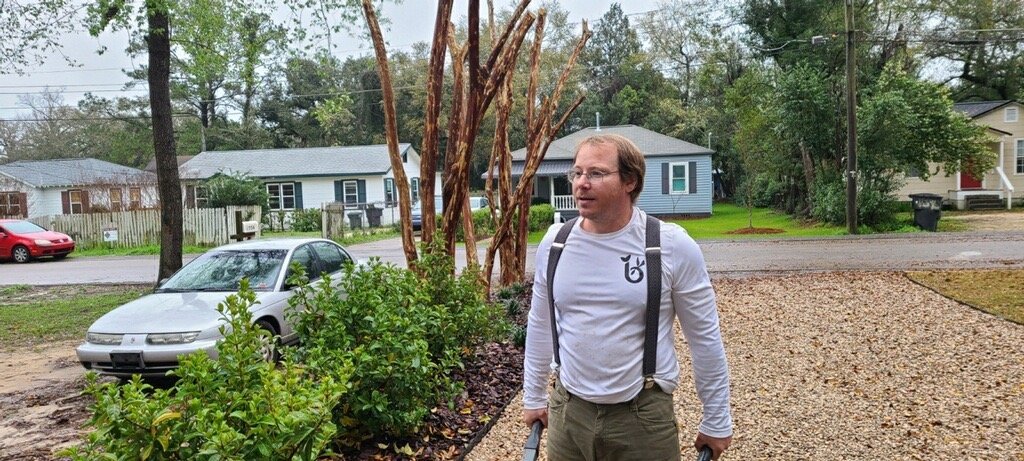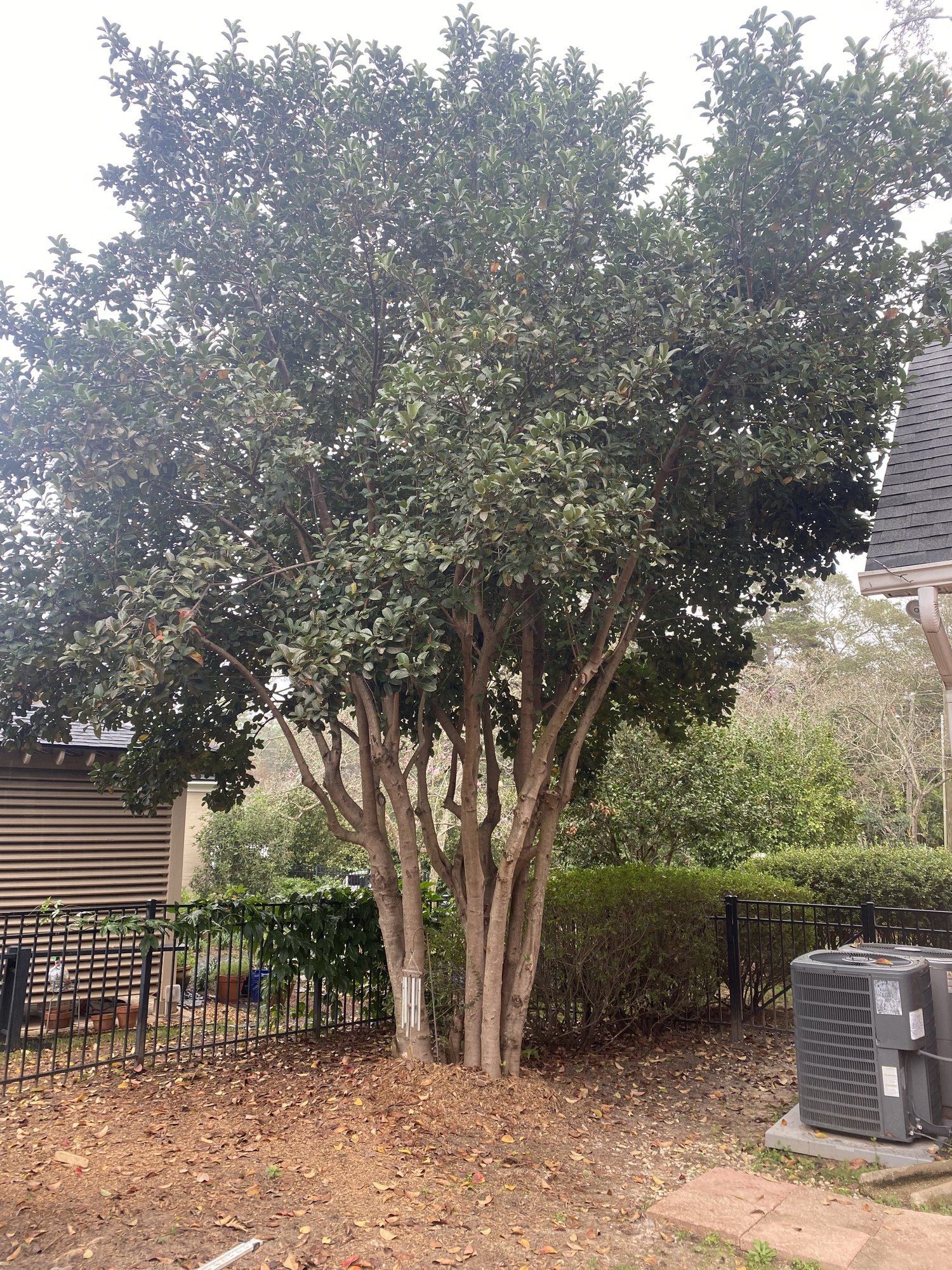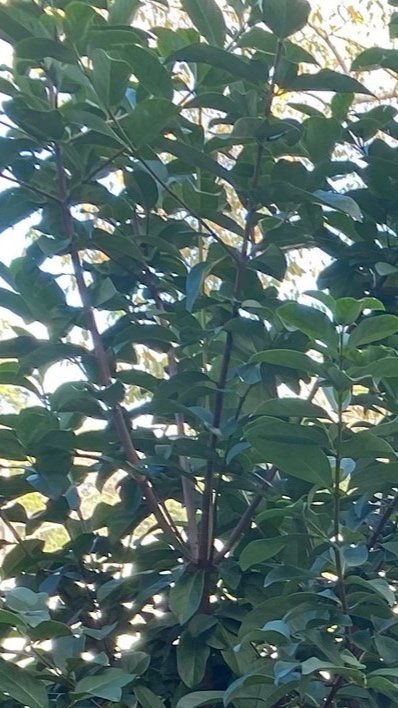Viburnatum Odoratissimum “Sweet Viburnum”
Tallahassee landscaping commonly requires hedges, and you cannot talk about hedges in Tallahassee without bringing up the king: viburnum odoratissimum, or sweet viburnum. Let’s take a look at this green behemoth at work:
7 Gal. Sweet Viburnums, planted by the indefatigable J.R. in February 2021.
This photo was taken from the same spot 18 months later. There’s a car on the other side.
Crazy Growth Rate
As you can see from the example above, we are talking about a growth rate of more than 2 feet per year in our region. That is basically insane. Customers who want growth fast will often ask if they can purchase these plants as 30 gallons, yielding a price difference of about 300%. While I do often recommend larger plants when it comes to certain varieties and uses, it is almost never financially reasonable to buy giant viburnums. When purchased at 7 gallons, they root quickly and start leaping by the next spring.
That being said, there are factors that yield higher growth rates and more lush growth. The first and most contributing factor is water. You are not going to kill this plant with inattention to watering (Tallahassee rains are sufficient for its survival), but you will temper the growth rate. The plants pictured above each received water from 1 GPH drip emitters 3-5 days per week for a duration of one hour per watering. They will explode with this kind of consistent watering.
Second, fertilization is important. Use plant tone monthly from spring to fall. This will keep the plant from yellowing and producing fewer leaves.
By following the tips above you will see results like the ones pictured above. Of course, the condition of your soil will also be a contributing factor, and I always recommend a soil test before you start making significant investments in plants for your yard.
You must PRUNE.
his viburnum has not been pruned for years, and has taken on a tree’s habit.
While the above maintenance tips will give you a fast-growing plant, they are not necessary for the plant to live. It is basically bulletproof. I have seen these plants go through massive droughts and show depressing amounts of wilt, only to bounce right back after a single rain. They are tough. The challenge with these plants is controlling them. You must prune these plants to keep them at the desired height, shape, and density. You cannot just let them go, or they will eventually turn into what they truly are: trees reaching heights upwards of 50 feet.
The biggest mistake we see is allowing them to go leggy (grow long spindly branches). In fact the ones discussed in this post are demonstrating this very problem. Let’s have a closer look…
This shows an area of the plant that split into (at least) 4 new branches this past summer. All four of these branches are new growth coming from one spot on an old branch. The spot that spawned those 4 new branches is the result of pruning. Pruning that branch forced it to produce side shoots, which will now do one of two things: (1) try to grow long and upward (toward the sun) or (2) be pruned and then create more side shoots of their own. Allowing branches to grow long and upward (not pruning) results in taller, thinner plants. When this happens and it is not desirable, we call it growing “leggy.” This is because the branch becomes long, woody, and noticeable—like a leg, I guess? I would say this particular instance is bordering on leggy and needs to be pruned as soon as possible before the overall habit gets off.
“But,” you might say, “I want the plant to be that tall! I don’t want to prune it, it is at the perfect height!” You might want it that tall, but doing it this way is too fast and loose. To make a tall hedge you must be methodical. You need to prune, allow some time for new side shoots to get going and then prune again, each time making the plant a few inches taller than it was the last time you pruned. If you do this, you will slowly bring the hedge up at a uniform rate with a consistent density. The hedging rhythm is part of the process: prune, thicken, prune slightly higher, thicken, prune slightly higher, etc. until we are at the exact height, width, and thickness we are trying to create.
“But,” you might say, “I don’t like formal looking hedges, I want them loose and natural.” I get it. But that is not an issue of whether or not you should prune, it is an issue of how you should prune and how often you should do it. Organic-looking hedges should be pruned less frequently and less uniformly, but still pruned to promote thickness and lush growth. A formal style hedge should be hedged once a month, maybe twice a month at peak growing season. An organic style hedge should be pruned once every 6 weeks with care to not use hedgers, but instead snipping just above the leaf nodes of branches. Staying right above the leaf nodes will give you a randomized pruning pattern instead of a straight, boxy look.
One more thing: They smell weird.
While its blossoms in early summer have a nice “sweet” odor to them, Sweet Viburnum’s foliage and branches smell—not good or bad—weird. I believe that the “odoratissimum” (strong smell) in its botanical name is a reference to this, and not the blooms. I can’t really describe the scent, but it is almost a burnt smell, emitting from the plant when it’s pruned, brushed against, etc. Those who are sensitive to scents would do well to give it a whiff before planting.
Brian Eltomi





